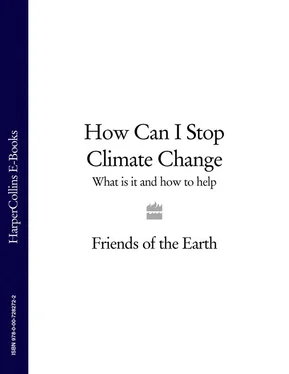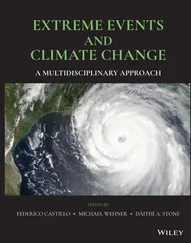Global warming affects our world from top to bottom, including sporting events such as the Australian Open, where 40 °C+ daytime temperatures forced night time play in 2006.
Farmer Alan Brown has survived ten years of below-average rainfall in New South Wales, Australia. In 2006 he had his worst year to date when, for the second time, his harvest completely failed.
An established farmer with 900 hectares of land and a mixture of sheep, cattle and winter crops, Alan says, ‘Everything I have revolves around the value of my land – and if my land is not producing, it isn’t worth anything.’ With less and less grazing available, Alan has taken to hand-feeding the animals for up to eight months of the year (he would normally do this for only three).
Winter rains are crucial in New South Wales. Moisture does not remain in the soil for long, and when winter rains fail, the outlook is dire, particularly for farmers who depend on irrigation. The financial effects are being felt in the wider community. Villages that once supported several shops and services are down to just one general store. Parents are finding it cheaper to move their children to cities for schooling – thus splitting the family. Alan worries that Australia is witnessing a prolonged drying, symptomatic of climate change. ‘If we are going to survive in a drier environment, we need plants that can survive with less water. It’s not something that we have bred for in the past.’
Covering an area of more than 2 million square miles, and home to a third of all animal species, the Amazon rainforest has been described as the Earth’s lungs. It absorbs vast quantities of carbon dioxide from the atmosphere, releasing oxygen and playing a crucial role in keeping our climate on an even keel.
But as our planet warms, this great natural resource is at risk from long periods of dry weather. In 2005 water in the Amazon River was so low that sections were impassable by boat. The Brazilian army was called in to distribute water and food, and big ships were left stranded. In one state alone, fire laid waste to 100,000 hectares of forest – an area two-thirds the size of Greater London. Scientists estimate that burning in the Amazon adds some 370 million tons of greenhouse gases into the atmosphere every year.
Some scientists say climate change is affecting the frequency of El Niño – the occasional reversal of the weather over the Pacific region. This phenomenon has a huge influence on weather systems around the world. During El Niño flooding becomes more likely on the Pacific coast of the Americas and cold water fish supplies disappear.
Dust storms are common in China when the wind blows. In northern China once-fertile land is being destroyed as the heat and lack of water kill vegetation. The dry soil quickly turns to dust. Dust and dried-up soil are whipped up from dry areas in the north of the country and move in clouds that can travel enormous distances – some have reached as far as Vladivostok in Russia.
Specially planted shrubs will form part of a 700 km live barrier, intended to hold back inner Mongolia’s desertification and prevent dust storms disrupting the 2008 Olympics in nearby Beijing.
In South Korea massive dust storms blowing over the border from China were so bad in 2002 that primary schools had to be closed. The storms, which have already cost China more than US $2 billion a year in lost land and productivity, threaten the livelihood of at least 170 million people, and are increasing in frequency. There are even fears that they could blight the 2008 Beijing Olympics. More than 30 per cent of the total land area of China is now being affected by desertification.
Indeed a third of the Earth’s land surface is vulnerable to desertification. Over-grazing and damaging irrigation schemes have already taken their toll, but climate change may be the final straw for such areas. According to the United Nations, desertification could drive 50 million people from their homes in the next ten years.
is California’s fruit bowl drying out?
It’s not only the poorest farmers who are losing out from climate change. California’s agriculture industry is worth an estimated US $30 billion and employs more than 1 million workers. The most populous state in the United States, California has a varied climate, from snowy mountains to desert heat, and the region is no stranger to extremes of weather. But global warming is likely to make those extremes much worse.
Fruit-growers know how sensitive trees are to changes in temperature. The trees need a cold period to allow buds to set, and then a steady warm period for fruit to grow. In hot weather fruit matures more quickly, producing earlier harvests and smaller fruit. Californian grapes are vulnerable to high temperatures, which can lead to premature ripening that affects the quality of the wine. The problems facing US farmers are recognised by Government. The US Congress in 2007 approved a US $3 billion agricultural disasters relief fund, specifically for farmers affected by weather events.
You may have drunk wines from California’s Napa Valley – it’s home to some of the New World’s finest.
Annie Favia has been working in Napa’s wine industry for more than ten years and says the changes in the climate are there to see. ‘I can’t say specifically that it is climate change, but it is definitely getting warmer,’ she says. ‘You get these heat spikes when you get scorching temperatures and they can last for up to a week at a time. The hot weather burns the fruit. The sugar level in the grape goes up before the fruit is ready and the result is you get higher and higher levels of alcohol.’
Annie and her husband Andy Erickson are small-scale producers, making up to 800 cases a year for the high end of the wine market: a bottle of Favia sells for between US $50 and US $500. Annie has tried to protect the grapes from the scorching temperatures, installing micro-sprinklers that spray a fine mist and keep the temperatures down. ‘We are using irrigation a lot more,’ she says. ‘So far it hasn’t been a problem for us, but there are a couple of regions in Napa that are water-deficient.’
More than 80 per cent of agriculture in California depends on irrigation, mainly fed by snow melt in the mountains. But snowfall is predicted to decline by anything from 30 to 90 per cent by the end of the century, leaving growers at the mercy of unreliable rain. ‘We are way out of control,’ says Annie. ‘We are changing things and we do not know what is going to happen. That is pretty scary.’
Farming is the backbone of most African economies. Four out of five Africans live in the countryside and farm or keep livestock for their livelihoods. As extreme weather hits the continent some of the world’s poorest people are bearing the brunt of climatic shifts. Eastern and Southern Africa have been badly affected by changes in rainfall. Until recently the rainy season would normally arrive in April and May but it hasn’t done so since 2002. Rivers and irrigation canals are running dry.
According to development agencies such as Christian Aid many people in rural areas are living on the edge of starvation. As temperatures rise, declining crop yields could leave hundreds of millions unable to produce or purchase enough food. In 2006 nearly 4 million
Читать дальше












